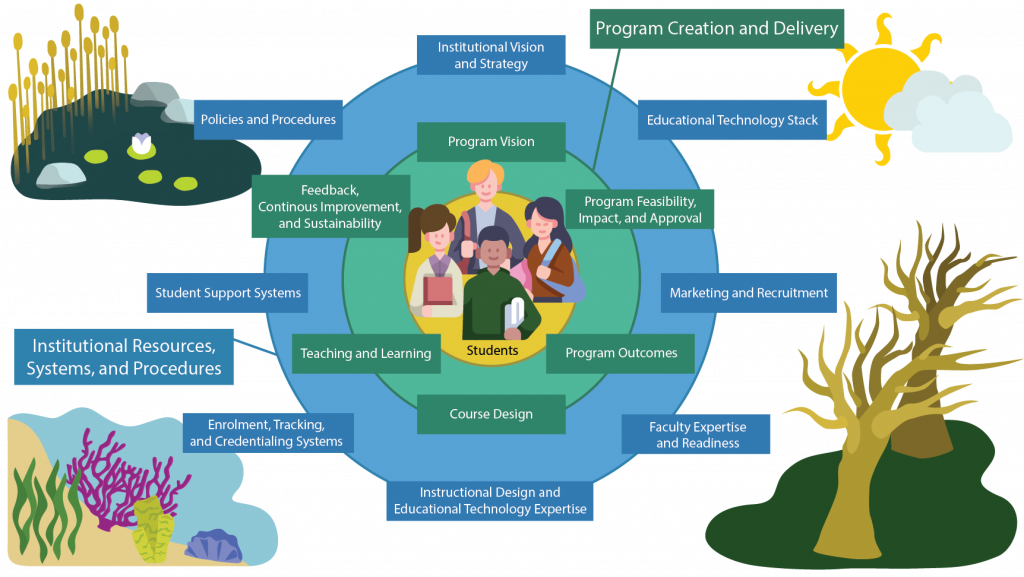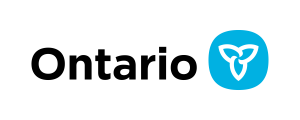About This Pressbook–Start Here!
Land Acknowledgment
The co-creators of this Pressbook acknowledge that this work was undertaken across the traditional territories of the Anishinaabek, Haudenosaunee, Lūnaapéewak, and Chonnonton Nations, on lands connected with the London Township and Sombra Treaties of 1796 and the Dish with One Spoon Covenant Wampum. These lands continue to be home to diverse Indigenous Peoples (First Nations, Métis and Inuit), whom we recognize as contemporary stewards of the land and vital contributors of our society.
Why Read this Book?
Welcome to Creating and Implementing High-Quality, Sustainable Online Programs! In this book, we invite you to learn about, reflect on, and lead planning conversations related to the interconnected elements that together create effective, sustainable, and student-centred online programs.
Online program development and implementation is a complex undertaking with many moving parts. Some are academic in nature. Some are technical. Some are financial. Some are administrative. All involve coordinating and collaborating across multiple areas of vision, expertise, administration, and resources. This book and its accompanying resources empower and enable leaders in Ontario’s post-secondary institutions to explore the “big picture” of online programs by engaging with the information and activities found here and applying it to their institutional context, no matter their level of experience with online programs.
The co-creators of this book use a student-centred ecosystem metaphor for online program development and implementation. When the elements of that system are thoughtfully tended and working in relation to one another, your program will thrive in how it supports students, faculty, staff, and the overall objectives of the program, institution, and community. Users of this book are invited to explore these ideas and apply practical activities to their online program development and its supporting “ecosystem” in their institutional context.

Who Is This Book For?
This book is primarily for post-secondary academic and staff leaders who are responsible for the development and implementation of one or more elements of the online program ecosystem. The aim is to look at online programs through strategic planning, “big picture” lens rather than focus on daily operations. The information and resources within are aimed at enabling individuals in these roles to assess–within their own institutions–current strengths, opportunities, and gaps in their readiness to design online programs, and then to lead conversations and collaborations that will result in short-, mid-, and long-term program planning and implementation. Leaders may find it helpful to share sections of this book with specific units or individuals responsible for the day-to-day development and implementation of the program to facilitate planning and collaboration.
How To Use This Book
This book is comprised of four modules, each of which has several units that explore the module’s topic in depth. Recognizing that readers of this book come to it with different levels of experience in designing online programs or that they may be responsible for different areas of development, each module is designed as a “standalone” unit. You may also choose to work through the book in its entirety.
We encourage you to document your responses to the reflection prompts and practical information arising from the research and collaboration activities in this book using the editable Workbook developed for this purpose. There are separate workbooks for each module, or you can use the complete Program Development and Implementation Workbook, which compiles all of the module workbooks into a single document. Prompts for workbook activities are enclosed in blue boxes throughout the book. You can find the workbooks by navigating to them from the Table of Contents or links provided throughout the book.

Self-check activities and questions are provided in each module that indicate when it might be helpful for you to review content in another area of the book before proceeding, if necessary.
Resources such as retreat plans and example templates are embedded throughout the book and summarized at the bottom of each module page in which they appear.

Module Summaries
Module 1: The Elements of Online Program Design and Collaboration describes the online student life cycle and the larger online ecosystem that makes up the development of highly effective programs, emphasizing the necessity of cross-unit or cross-institutional collaboration in online program development and implementation. It also provides information on the units and roles commonly included in this work, tools to assess your institutional “readiness” to undertake it, and models for how that work might be structured.
Module 2: Program Vision, Feasibility, and Approval walks readers through the process of setting an online program up for success by creating a strong program vision and assessing its feasibility in relation to guidelines set by your institutional context as part of the program approval process. It emphasizes the role of collaboration in establishing program outcomes and planning wisely for the development of the program, including timelines and resourcing—particularly those that are specific to online programs.
Module 3: Course Design and Implementation explores the process of visioning the program’s curriculum, including choosing core competencies and/or teaching approaches and eLearning tools to create a consistent and effective student learner experience in the program. It provides examples and tools to help program designers map out learner pathways through the program and embed essential elements such as learner persistence, teaching and learner-driven technologies, and decolonization into courses.
Module 4: Building Sustainable Online Programs emphasizes the importance of building sustainability into your online program development work from Day 1. It encourages developers to look beyond participation in mandated academic quality assurance processes to create their own “blueprint” for program sustainability and continuous improvement that accounts for all areas of the online program ecosystem. The module contains information and tools to help you assess your institutional or departmental readiness to develop and implement a sustainability plan as well as an editable template to document your plan.
Authors
Dr. Lauren Anstey (she/her) is Associate Director of Educational Development at Queen’s University Centre for Teaching and Learning. Her PhD (Faculty of Education, Queen’s University) is in Curriculum Theory, and her Educational Development work often focuses on curriculum development, continuous improvement, and blended and online academic program design. Lauren identifies as a cis-gendered woman, and as a settler-Canadian with European heritage. Lauren lives in Kingston, Ontario with her husband and two children.
Dr. Stephanie Horsley (she/her) is Associate Director of eLearning at Western University’s Centre for Teaching and Learning and Adjunct Assistant Professor in Music Education at the Don Wright Faculty of Music. Stephanie leads a team of Educational Developers and Instructional Designers focused on course, program, and institutional-level selection and implementation of technology-enhanced learning across all teaching modalities. Her work is guided by her belief in the importance of student-centred learning, specifically the ways in which technology can be leveraged to connect classroom to community and empower students to take an active, confident role in their learning.
Dr. Denise Stockley (she/her) is a Professor and Scholar in Higher Education with the Office of the Provost (Teaching and Learning Portfolio) and the Faculty of Health Sciences at Queen’s University. She completed her Doctorate in the Psychology of Education at Simon Fraser University. Denise is the Principal Investigator of several research grants in a variety of areas including those from the Tri-Council (SSHRC, NSERC, and CIHR) focusing on research ethics education, quality assurance, and competency-based medical education to name just a few of her projects.
Mr. Greg Yantz (he/him) currently serves as the Director of the Centre for Academic Excellence (CAE) at Fanshawe College: a team supporting the College’s focus on student success through curriculum quality assurance and new program development that meets community needs. Greg also held roles as Associate Dean of Fanshawe’s Woodstock/Oxford Regional Campus and worked at Western University in the Don Wright Faculty of Music and the Ivey Business School. Greg is a graduate of New York University having earned a Master of Arts (Politics), and a Master of Philosophy (Politics). He graduated from the University of Michigan with a Bachelor of Arts in Political Science.
Contributors
Denise Quildon is an Instructional Designer at Western University. She holds a master’s degree in Educational Technology. She has held various roles over the last 20 years and counting designing classroom and technology-based learning solutions for both adults and young learners. Denise contributed to this book as project manager and instructional designer.
Allyson Steward is an eLearning Technology Specialist at Western University. She completed her Bachelor of Arts in Film Studies in 2019 and is currently in progress on her Master’s of Library and Information Science (Western University). Allyson coordinated the digital content creation for this book with a team of student Digital Media Designers from the Instructional Technology Resource Centre at Western University and oversaw all elements of digital production and integration.
Video Contributors
The following individuals and teams have graciously shared their time to compliment our project with their valuable insights and expertise:
Cebert Adamson, Vice President of Students, International, and Alumni , Mohawk College
Margaret (Maggie) Cusson, Dean of Academic Development, Algonquin College
Patrick Devey, Associate Vice President of Global, Online, and Corporate Learning, Algonquin College in Ottawa
Engineering Team, Queens University
- Brittany McRae, Project Manager and Instructional Designer
- Pierre Laflamme, Content Expert as a Health, Safety and Risk Manager
- John Mckay, Content Expert as a Safety Engineer
- Ernesto Travieso Florez, Media Production Specialist
Flight Services Team, Fanshawe College
- Larry Weir, Associate Dean, Norton Wolf School of Aviation & Aerospace Technology
- Haley Whitelaw, Curriculum Developer & Professor, Norton Wolf School of Aviation & Aerospace Technology
- Melissa Barnard, Curriculum Consultant and Professor, Centre for Academic Excellence, Fanshawe College
- Tracey Davies, Program Manager, Faculty of Science Trades and Technology, Fanshawe College
- Tyson Macklin, Educational Support Technologist, Faculty of Science Trades and Technology, Fanshawe College
Funding
This project is made possible with funding by the Government of Ontario and through eCampusOntario’s support of the Virtual Learning Strategy. To learn more about the Virtual Learning Strategy visit: https://vls.ecampusontario.ca.
Adopting and Adapting this Book
This resource is licensed under an Ontario Commons Licence and Creative Commons License BY-NC-SA that allows for copying, use, and modifications under the following conditions:
- attribution to this original work (BY),
- noncommercial use (NC), and
- modifications are shared alike (SA) retaining this same CC license.
There are a few exceptions in this book to this license. They occur where the copyright is held by another author or organization who has given their permission to incorporated them into this book. These exemptions cannot be copied or modified without permission from the original copyright holder. They appear with a copyright symbol © and shortened citation. Their full citation is found in the Module Conclusion and References page.



